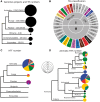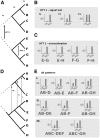Horizontal transposon transfer in eukarya: detection, bias, and perspectives
- PMID: 22798449
- PMCID: PMC3516303
- DOI: 10.1093/gbe/evs055
Horizontal transposon transfer in eukarya: detection, bias, and perspectives
Abstract
The genetic similarity observed among species is normally attributed to the existence of a common ancestor. However, a growing body of evidence suggests that the exchange of genetic material is not limited to the transfer from parent to offspring but can also occur through horizontal transfer (HT). Transposable elements (TEs) are DNA fragments with an innate propensity for HT; they are mobile and possess parasitic characteristics that allow them to exist and proliferate within host genomes. However, horizontal transposon transfer (HTT) is not easily detected, primarily because the complex TE life cycle can generate phylogenetic patterns similar to those expected for HTT events. The increasingly large number of new genome projects, in all branches of life, has provided an unprecedented opportunity to evaluate the TE content and HTT events in these species, although a standardized method of HTT detection is required before trends in the HTT rates can be evaluated in a wide range of eukaryotic taxa and predictions about these events can be made. Thus, we propose a straightforward hypothesis test that can be used by TE specialists and nonspecialists alike to discriminate between HTT events and natural TE life cycle patterns. We also discuss several plausible explanations and predictions for the distribution and frequency of HTT and for the inherent biases of HTT detection. Finally, we discuss some of the methodological concerns for HTT detection that may result in the underestimation and overestimation of HTT rates during eukaryotic genome evolution.
Figures



References
Publication types
MeSH terms
Substances
LinkOut - more resources
Full Text Sources

